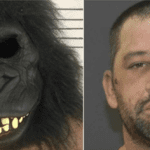 Mysteries
Mysteries  Mysteries
Mysteries  History
History 10 Surprising Stories About the Texas Rangers
 Humans
Humans 10 Philosophers Who Were Driven Mad by Their Own Theories
 Miscellaneous
Miscellaneous 10 Video-Game-Worthy Weapons and Armors from History
 Weird Stuff
Weird Stuff 10 Psychics Who Accurately Predicted Wartime Events
 The Arts
The Arts 10 Pieces of Art Inspired by a Broken Heart
 Health
Health 10 Science Fiction-Sounding New Medical Treatments
 History
History 10 Surprising Facts About the Father of Submarine Warfare
 Space
Space Ten Astonishing New Insights into Alien Worlds
 Weird Stuff
Weird Stuff 10 Bizarre Summer Solstice Rituals Still Practiced Today
 Mysteries
Mysteries Top 10 Haunting Facts About the Ghost Ship MV Alta
 History
History 10 Surprising Stories About the Texas Rangers
 Humans
Humans 10 Philosophers Who Were Driven Mad by Their Own Theories
Who's Behind Listverse?

Jamie Frater
Head Editor
Jamie founded Listverse due to an insatiable desire to share fascinating, obscure, and bizarre facts. He has been a guest speaker on numerous national radio and television stations and is a five time published author.
More About Us Miscellaneous
Miscellaneous 10 Video-Game-Worthy Weapons and Armors from History
 Weird Stuff
Weird Stuff 10 Psychics Who Accurately Predicted Wartime Events
 The Arts
The Arts 10 Pieces of Art Inspired by a Broken Heart
 Health
Health 10 Science Fiction-Sounding New Medical Treatments
 History
History 10 Surprising Facts About the Father of Submarine Warfare
 Space
Space Ten Astonishing New Insights into Alien Worlds
 Weird Stuff
Weird Stuff 10 Bizarre Summer Solstice Rituals Still Practiced Today
10 Times Animals Helped to Solve Crimes
Not all heroes wear capes, as the saying goes.
Advances in animal DNA technology now stand at the forefront of forensic science. Enhanced testing techniques and ever-expanding databases are helping law enforcement agencies to catch criminals. In recent years, the hair, fur, feathers, blood, and other bodily fluids from cats, dogs, birds, and other animals have helped solve countless violent crimes around the globe.
Here are ten crimes where critters have played a significant role in bringing the guilty to justice—using DNA technology, as well as some other weird and wonderful crime-fighting abilities.
Related: Top 10 Mysteries And Crimes Solved By The Internet
10 Duck for Cover
A pet duck recently led police in North Carolina to the decomposed body of missing 92-year-old grandmother Nellie Sullivan. Sgt. Mark Walker of the Buncombe County Sheriff’s office explained how “the duck ran underneath the trailer at 11 Beady Eyed Lane, and as they were chasing after their pet duck, they ran across the container that Nellie Sullivan was located in.”
Beady Eyed Lane? You just can’t make these things up!
Even before the grim discovery of the remains, Nellie’s own granddaughter Angela Wamsley and her boyfriend Mark Barnes had been charged with concealing her death, along with charges of animal cruelty and drug possession.
Sgt. Walker described the initial search for Nellie as being “a wild goose chase.” Nothing turned up after numerous local searches, and Nellie’s neighbors had insisted she had, in fact, gone missing several years prior. Wamsley and Barnes had been collecting Nellie’s social security and retirement benefit check, as well as refilling her prescriptions in her absence.
“If I could give that duck a medal, I would,” Walker added.[1]
9 Bird the…umm…Bird
Texan Kevin Butler was apparently such a fan of NBA great Larry Bird that he named his white-crested cockatoo after him. Friends described Bird as being very devoted to Butler. This was even more evident after two men broke into Butler’s Pleasant Grove home on Christmas Eve 2001. Bird loyally tried to defend his home and his owner. Unfortunately, Butler was bound, brutally beaten, and ultimately stabbed multiple times, causing his death. Sadly, Bird, too, was mortally wounded during the altercation—stabbed with a fork. Afterward, the men escaped into the night.
But Bird ultimately saved the day, providing investigators with the evidence they needed to solve the crime and secure a conviction. Following the attack, DNA recovered from Bird’s beak and claws was matched to a man named Daniel Torres, a disgruntled former employee at Butler’s pool company. Torres also wiped the blood off his head after being badly pecked by Bird and then touched a light switch, leaving trace evidence and putting him at the crime scene.
Faced with the evidence, Torres confessed to killing both Butler and Bird. He was eventually convicted of murder and sentenced to life in prison. They were also able to track down Torres’s accomplice, his half-brother Johnny Serna.
During the trial, the prosecutor submitted to the court that “Bird died valiantly. There were feathers scattered through the house, and he put up a fight, no doubt about that. Kevin’s family and co-workers have told me that you just didn’t mess with Kevin while that bird was around.”[2]
8 A Snowball’s Chance in Hell
In 1994, on Canada’s Prince Edward Island, a 32-year-old mother of five, Shirley Duguay, vanished without a trace. Many people suspected that her sometimes boyfriend, ex-con Douglas Beamish, was somehow involved in her disappearance.
Three days after she went missing, a blood-stained men’s jacket was found in a bag in the woods near Duguay’s home. The jacket also contained several white cat hairs. A detective on the case, Constable Roger Savoie, recalled seeing a white cat in Beamish’s home while investigating Shirley’s disappearance. Savoie sent the hairs to be DNA tested, and it was confirmed that they belonged to Beamish’s family pet, a white tomcat named Snowball.
It was the very early days of animal DNA testing, and Constable Savoie even went cat-catching and collected blood samples from a bunch of neighborhood strays. Much to his relief, their DNA profiles were all quite different. Statistically, the chance of another cat having DNA similar to Snowball’s was revealed to be one in some forty-five million.
Around this time, Shirley’s body was discovered by a local fisherman, and Beamish was arrested. While his defense attorney argued that “without the cat, the case falls flat,” Beamish was convicted of second-degree murder and sentenced to life with no eligibility for parole for 18 years. This is believed to be the first time animal DNA was used to successfully convict a criminal.[3]
Go, Snowball, go!
7 Dodgy Doggy DNA
In 1998, a Seattle, Washington, couple, Raquel Rivera and Jay Johnson, were found slain along with their pitbull-lab mix pup, Chief. All three were victims of a home invasion gone horribly wrong. While standing trial, suspects Ken Leuluaialii and George Tuilefano were surprised to learn that prosecutors planned to introduce an unlikely piece of evidence, Chief’s DNA. Dog blood had been found on the defendants’ clothing during the investigation, and forensic testing was able to match it to Chief.
In his opening argument, prosecutor Tim Bradshaw stated that “the irony will be that the witness who could never speak, even when he was alive, will present the most eloquent of evidence.” Prosecutors said that Tuilefano and Leuluaialii kicked down the door of the house after Johnson refused to sell them marijuana, then opened fire, shooting the dog first, before killing the couple. DNA evidence indicated that bloodstains on the two jackets and pants linked to Leuluaialii and Tuilefano were from Chief.
While the science of animal DNA was not yet as reliable as that of human DNA at the time, the state Court of Appeals later upheld the murder convictions of the two men. It even ruled that one should be re-sentenced to a longer prison term.
Joy Halverson, a senior scientist at PE AgGen, the company that tested the bloodstains, said that cat DNA was used in a criminal case in Canada (see above) but that this may be the first time DNA from a dog had been used in the United States. The tests showed there was only one chance in 350 million that the blood was not Chief’s.[4]
6 Layla Van Dam
On the night of Feb 1, 2001, in the Sabre Springs neighborhood of San Diego, 7-year-old Danielle Van Dam vanished from her own bed without a trace. Police had little to no evidence to go on. Eventually, neighbor David Westerfield came to the attention of investigators. Westerfield was acting suspiciously, often leaving his house during searches for missing Danielle. He was also seen at a dry cleaner just days after Danielle’s abduction, dressed only in his underwear on a cold morning. He gave the dry cleaners two comforters, two pillowcases, and a jacket.
Police obtained a search warrant for Westerfield’s home and found hairs that matched the Van Dam’s dog, a Weimaraner named Layla. According to prosecutors, the dog hair was attached to Danielle’s pajamas and was left behind in Westerfield’s home. In addition, Danielle’s blood was found on Westerfield’s jacket retrieved from the dry cleaner, and hair from her dog was also discovered on the comforter. Danielle’s blood was also found in Westerfield’s RV, the one in which he’d left town to stay in the desert just minutes after Danielle’s parents had discovered that she was missing and frantically dialed 911.
Hundreds of volunteers had been involved in searching the desert, highways, and remote areas for weeks. Finally, on Feb 27, searchers found her nude, partially decomposed body near a remote trail. Some searchers had decided to search this particular area as it was a possible route that Westerfield could have taken to get to the desert the night that Danielle disappeared.
It was enough evidence to charge and convict Westerfield of abduction and murder. As a result, he was sentenced to death on August 21, 2002, and he is still currently awaiting execution. (Because of the continuing 2006 moratorium on executions in California, and the July 2014 ruling on the unconstitutionality of the death penalty in California, it is not known when or if Westerfield will face execution.)[5]
5 Two Cats, One Murder
When Pennsylvania pet shop worker Lori Auker disappeared on her way to work in May 1989, her family imagined the worst. Unfortunately, their fears were confirmed when after three weeks of searching, Lori’s decomposed body was discovered in a remote wooded area. Her identity was confirmed through dental records, and Deputy Coroner Matthew determined that Lori had died after being stabbed numerous times.
Police immediately focused their attention on her estranged husband, Robert Auker, who had been stalking her in the weeks leading up to her death. The couple was involved in a bitter child custody battle and financial support dispute. However, it was also later revealed that Robert had recently taken out a substantial life insurance policy on her, despite the couple being in the middle of a messy separation when she disappeared.
Robert’s own mother and stepfather reported to police that he had been ferociously scrubbing his vehicle clean before selling it shortly after Lori’s disappearance. Despite his best efforts, forensic examiners found several cat hairs in the car that later proved to be an exact match with Lori’s two cats. The same fur was also stuck to a Velcro splint Auker had been wearing on his hand the day Lori disappeared.
In March 1992, Robert Donald Auker was convicted of kidnapping and murder and sentenced to death.[6]
4 “Don’t f—ing shoot!”
Eye witness testimony is often crucial when it comes to solving a crime. In this instance, the eyewitness in question was a 20-year-old African Grey parrot named Bud. Several weeks after the 2015 murder of Sand Lake, Michigan, resident Martin Duram, Bud began repeating an argument between two people. It ended in what is believed to be Duram’s last words, as the parrot repeated the phrase, “Don’t f—ing shoot!” mimicking the late owner’s voice.
It turned out that Martin’s wife, Glenna Duram, shot her husband five times in front of Bud before turning the gun on herself in a failed suicide attempt. She suffered a head wound in the incident but survived. She was ultimately convicted of first-degree murder in the killing of her husband after an eight-hour jury deliberation.
While Bud’s eyewitness account was ultimately not used in the court proceeding, for many people involved in the case, it just proved that the jury had come to the right decision. Duram’s parents were sure that the salty-mouthed bird had overheard the couple arguing and was repeating their final words. His mother asserted, “that bird picks up everything and anything, and it’s got the filthiest mouth around.”[7]
3 Yet Another Mouthy Parrot
In 2014, when Neelam Sharma was killed in her home in Agra, India, along with her pet dog, the local police had few leads to go on. That was until a parrot named Heera provided them with a vital clue.
Heera was the only witness to Sharma’s murder, as the attacker had killed the family dog, who had been barking throughout the struggle. Neelam’s grieving husband, Vijay Sharma, was also at a loss as to who could have perpetrated the violent crime. That is until a family member pointed out to him how Heera would become highly agitated whenever his nephew, Ashutosh, visited or even when his name was mentioned in passing.
Vijay informed the police of his suspicions, and Ashutosh eventually confessed to the robbery-turned-murder of his aunt. Ashutosh and an accomplice had entered the house intending to steal cash and other valuables items. He stabbed his aunt to death when they were caught in the act, afraid she would recognize him.
Police later downplayed the bird’s participation in solving the crime, saying it was an unexplained bite mark on Ashutosh that made him the primary focus of their investigation. However, a local newspaper reported that when investigators spoke with Heera and read through a list of suspects, the bird supposedly squawked, “Usne maara, usne maara,” which translates as “he’s the killer, he’s the killer,” when Ashutosh’s name was read.[8]
2 A Random Grasshopper
According to forensic entomologist M. Lee Goff, the 1985 murder of a woman in Texas was ultimately solved by a dead, mangled grasshopper that had been found on the victim’s clothing. The insect was missing a limb, and a close investigation of one of the main suspects revealed that he just so happened to have the severed hind leg of a grasshopper attached to the cuff of his pants. When Goff re-assembled the insect, he found it to be a perfect match, and the fracture lines lined up absolutely perfectly.
Although the defense argued in court that ”grasshoppers always break their legs like that,” the evidence was conclusive. It was impossible to deny that the stray grasshopper leg on the suspect matched what was missing from the grasshopper recovered from the victim’s body. The suspect was convicted of the woman’s murder, and many consider this case to signify the birth of forensic etymology.[9]
1 Scooby-Doo Saves the Day
A real-life Scooby-Doo created legal history in Paris, France, when he actually took to the witness stand to “testify” at his owner’s murder trial. When Scooby’s owner was found hanging from the ceiling in her apartment, her death was initially presumed to be a suicide. However, the woman’s family had some suspicions and persuaded the police to open a murder investigation. They identified a suspect, and the man was brought to court for a preliminary hearing to decide if there was sufficient evidence to launch a full murder inquiry.
As Scooby was in the apartment at the time of the alleged murder, he went to the witness box. When faced with the potential killer, he immediately reacted and “barked furiously.” A court clerk actually recorded Scooby’s barks and noted his “general behavior throughout the cross-examination.” After Scooby gave his “evidence,” Judge Thomas Cassuto praised him for his “exemplary behavior and invaluable assistance.”
While prosecution lawyers welcomed the dog’s appearance in court, others doubted that the animal’s behavior could be interpreted as actual legal binding, legitimate evidence. Some critics of the move pointed out that the two-and-a-half years since the death of Scooby’s owner is the equivalent of approximately 17 dog years. “That’s a long time for a dog to remember what went on,” explained a legal source close to the case.
A spokesman for the Palais de Justice in Paris confirmed that the case was the first time a dog had appeared as a witness in criminal proceedings in France. He said he was almost certain it was also a world first in legal history.[10]








